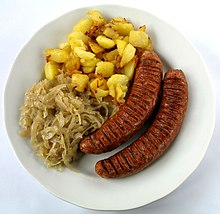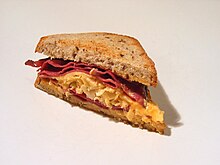sauerkraut
Sauerkraut or sauerkohl is white cabbage or pointed cabbage preserved through lactic acid fermentation and is usually consumed cooked as a side dish. It is internationally recognized as one of the most famous German national dishes .
ingredients
Sauerkraut is rich in lactic acid , vitamins A , B , C and minerals and, together with the cabbage vegetables, is an important domestic vitamin C supplier in winter . Sauerkraut has a relatively low physiological calorific value of approx. 80 kJ / 100 g (19 kcal / 100 g), is practically fat-free , contains 3 to 4% carbohydrates and 1 to 2% proteins . The histamine it contains can cause digestive problems in the event of intolerance.
According to a study published by the German Heart Foundation in 2008, the high vitamin K content stated in many works is actually only an average of 7.7 μg / 100 g sauerkraut.
history

just goes
into the cellar with a plate ,
That she fetches
a portion of the sauerkohle,
which she especially raves
when it warms up again.
Preserving vegetables through lactic acid fermentation is a very old technique practiced in different parts of the world. In ancient Greece and the Roman Empire so soured cabbage was known well in China .
The Korean variant of sauerkraut, kimchi , was developed as early as the 7th century . It differs from the European sauerkraut, which is called "Togil Kimchi" there, through the use of Chinese cabbage and other Asian ingredients.
Sauerkraut was mentioned in the story Meier Helmbrecht around 1270 :
- a krût vil small cut;
- skinny and thin, in bêden siten,
- a good meat lac dâ bî.
The Greek natural philosophers are known to recommend sauerkraut.
Until newer preservation methods were established, sauerkraut was one of the main ingredients processed in winter in Germany , the Netherlands and Poland . It also found its way into the Jewish kitchen . A lot of sauerkraut is consumed, especially in Eastern European countries. Due to its high vitamin content (especially vitamin C), it prevented deficiency symptoms in winter . That is why it was used all year round as a provisions for seafaring after it was discovered in the 18th century that the consumption of sauerkraut prevents scurvy .
During the First World War , sauerkraut was renamed liberty cabbage in the United States . Especially during the Second World War , the stereotyping term Krauts for Germans (or Kraut for Germans ) was often used in the English-speaking world , which is probably due to the traditionally high consumption of sauerkraut during the winter months in Central Europe, especially in Germany.
Manufacturing
Fresh white cabbage without the stalk is cut into fine strips with a cabbage slicer, for example , and placed in a saucepan. The then mixed in salt (1.5%) removes the liquid from the white cabbage during fermentation and preserves the juice until fermentation is sufficiently advanced. The plant cells are burst with a cabbage masher, the cell sap can escape and finally has to cover the cabbage completely. The lactic acid bacteria present in the air and adhering to the cabbage start the fermentation process.
With wine sauerkraut or wine cabbage , some white wine is also added. The brine must cover the cabbage during the fermentation period (4 to 6 weeks). Therefore, the cabbage must be weighed down with weights during fermentation. During fermentation no air should get to the cabbage, otherwise instead of the desired lactic acid fermentation z. B. Mold can occur. If fermentation has progressed to the point where the pH value is sufficiently low , harmful bacteria ( putrefaction ) and fungi (e.g. yeast ) are inhibited or killed. After all, the herb is so sour that it will last.
Originally, wooden barrels were used (as was the case with salted meat or salted beans ), later sauerkraut pots made of earthenware were used for preparation. The sauerkraut pot has a circumferential channel to allow air to be sealed off and gases to escape at the same time. An attached lid plunges all around into the salt water in the channel and prevents air from entering. The pickled goods must never protrude from the brine, otherwise it can go moldy and take on a bad taste that affects the entire herb. It must therefore be checked and, if necessary, topped up with brine .
Sauerkraut has been produced industrially since the late 19th century , initially in wooden barrels and now in airtight fermentation silos. The oldest German sauerkraut factory is the Leuchtenberg sauerkraut factory in Neuss . Sauerkraut has been traditionally produced there since 1861. Today's industrially produced sauerkraut often has additional vitamin C added as an antioxidant . This increases the shelf life.
With today's hygienic production and storage conditions, lactic acid bacteria may need to be added separately in order to avoid incorrect fermentation. The type Leuconostoc mesenteroides used is also used by dairies .
The fermentation process in industrial production is divided into three phases:
- Phase (the first three days)
- Yeasts and acetic acid bacteria develop (these are already present in the substrate), which consume the remaining oxygen and produce ethanol , acids and esters .
- Phase (another three days)
- There are heterofermentative lactic acid bacteria (eg. As Leuconostoc TYPES as Leuconostoc mesenteroides ) was added. They form lactic acid, acetic acid , mannitol and carbon dioxide . The pH drops. The ethanol present in the substrate esterifies with acids and becomes an important flavor component in sauerkraut. The lower the pH, the more undesirable foreign organisms such as clostridia are inhibited in their growth. The lactic acid bacteria produce lactic acid until its concentration has risen to 2%. The growth of the MS bacteria is then also inhibited.
- Phase (from an acidity of 1–2%, 3–6 weeks)
- There are homofermentative added lactic acid bacteria, which are still acid-tolerant, for. B. Lactobacillus species such as Lactobacillus brevis . The fermentation period is 3–4 weeks at room temperature and 5–6 weeks at cellar temperature.
preparation
In sauerkraut and white cabbage, ascorbic acid is also bound in the form of ascorbents A and B (C-2-scatyl-L-ascorbic acid). When the vegetables are cooked, the molecules break down into L-ascorbic acid and 3-hydroxyindole, so that they contain more vitamin C when cooked than when raw. However, cooking too long will destroy the vitamin. Sauerkraut is available loose from butchers , health food stores and markets . Otherwise it comes on the market as permanent preservation in cans , jars or in sealed plastic bags.
Sauerkraut is steamed with a little water or broth and fat. Usual spices are - besides salt and pepper - bay leaves , juniper , caraway seeds , cloves , marjoram , also tarragon , fennel seeds , savory or sugar . Depending on the region, ingredients such as onions , apples or grapes are added. In Hesse , for example, this is apple juice and in Thuringia beer . In some regional kitchens, a slight bond through a roux or z. B. known in the Silesian cuisine for the few potatoes that are cooked with it; Small amounts of grated potatoes are also added to the cabbage in southern Bavaria.
Sauerkraut dishes
Sauerkraut dishes have a great regional diversity. In the German-speaking area , this includes the following examples:
- With the Hessian ribs with cabbage , cured pork chops are cooked in sauerkraut.
- Sauerkraut is an important part of Bavarian cuisine , mostly seasoned with caraway seeds and often lightly bound with roux.
- Sauerkraut is also part of Swabian cuisine . The Filder south of Stuttgart are one of the most famous growing areas for pointed cabbage ( Filderkraut ) . The Filderkraut Festival is celebrated every year in Leinfelden-Echterdingen . Typical of Swabian cuisine is bacon with sauerkraut, also with potato noodles .
- In Berlin and Brandenburg cuisine Sauerkraut is often served as a side dish.
- In Franconia , sauerkraut that has been cooked several times is given meat deposits. These give a strong taste.
- The sauerkraut in Saxony is similar to the Franconian, but is often seasoned with more caraway.
- In the whole southern German-speaking area it is served with a slaughter plate with kettle meat and boiled blood and liver sausages.
- In Austria it is part of the farmer's feast with roasted and cured meat (or roast pork and smoked meat), Frankfurter sausages and dumplings .
- Also in Austria it is a traditional dish for roast pork with potato dumplings .
- In Switzerland , for example, sauerkraut is served with the Bernese platter .
- In Heilbronn , Germany, a casserole is prepared for the sauerkraut alternating with coarse liver sausage and mashed potatoes in a casserole dish and then baked in the oven until the top layer of mashed potatoes turns a light brown. Bread and / or potato noodles are also served.
- Klunz is a Central German dish with sauerkraut and lard .
The following variants are known internationally:
- The Alsatian form of the meat platter is Choucroute garnie , "garnished sauerkraut".
- In the Szegediner goulash from the Hungarian cuisine , a goulash is mixed with a lot of sauerkraut and some sour cream.
- Sauerkraut is an essential part of the Polish national dish bigos.
- In the Czech Republic it is part of the national dish “Vepřo-knedlo-zelo” (roast with dumplings and cabbage).
- Sarma is popular in the Balkans (especially Romania , Bulgaria and Serbia ) : Whole, leavened cabbages are "defoliated", these leaves are filled with a spicy farce made from rice, then cooked in sauerkraut in the oven or boiled in a sweaty liquid.
- In the US , sauerkraut is part of the Reuben sandwich made from rye bread, corned beef , Swiss cheese and salad dressing , which is roasted before consumption. The hot dog sausage is also often topped with a sauerkraut topping , especially in New York City .
Further use
- Sauerkraut juice is a vegetable juice made from pressed, raw sauerkraut. Sauerkraut juice contains a lot of vitamin C, lactic acid and live lactic acid bacteria . It is considered to stimulate digestion .
Web links
- Sauerkraut . Entry No. 188 in the register of traditional foods of the Austrian Federal Ministry for Agriculture, Regions and Tourism .
Individual evidence
- ↑ In the test: Sauerkraut (PDF; 32 kB); Vitamin K in foods (PDF; 52 kB) ; SW Souci / W. Expert / H. Kraut: The composition of food - nutritional tables. 7th edition. 2008, ISBN 978-3-8047-5038-8 .
- ↑ http://www.hs-augsburg.de/~harsch/germanica/Chronologie/13Jh/Helmbrecht/hel_meir.html
- ↑ Sauerkraut . Entry No. 188 in the register of traditional foods of the Austrian Federal Ministry for Agriculture, Regions and Tourism .
- ↑ Thomas Reuther: The ambivalent normalization. Discourse on Germany and images of Germany in the USA, 1941–1955. Stuttgart 2000. p. 65.
- ↑ a b https://www.kochbar.de/rezept/265348/Beilage-Sauerkraut-selbermachen.html
- ↑ Gerhard G. Habermehl, Peter E. Hammann, Hans C. Krebs and W. Ternes: Naturstoffchemie: An introduction . Springer Verlag Berlin, 3rd completely revised. u. exp. Edition 2008, ISBN 978-3-540-73732-2 , p. 666.
- ↑ Roast pork . Entry no. 180 in the register of traditional foods of the Austrian Federal Ministry for Agriculture, Regions and Tourism .
- ↑ Erhard Gorys, Das neue Küchenlexikon, dtv, Munich 1994–2002, ISBN 3-423-36245-6 .





